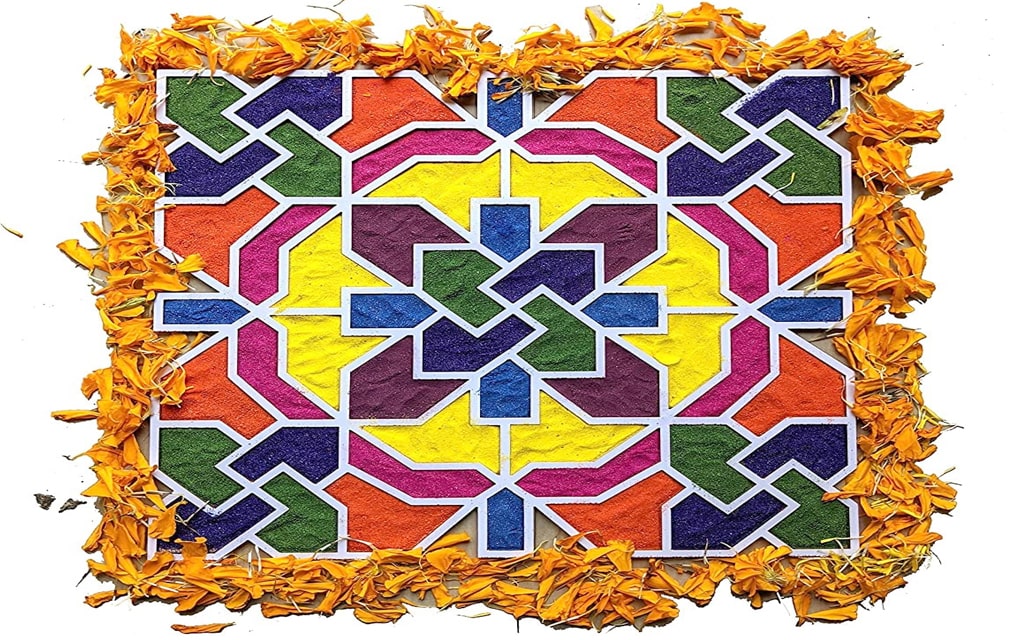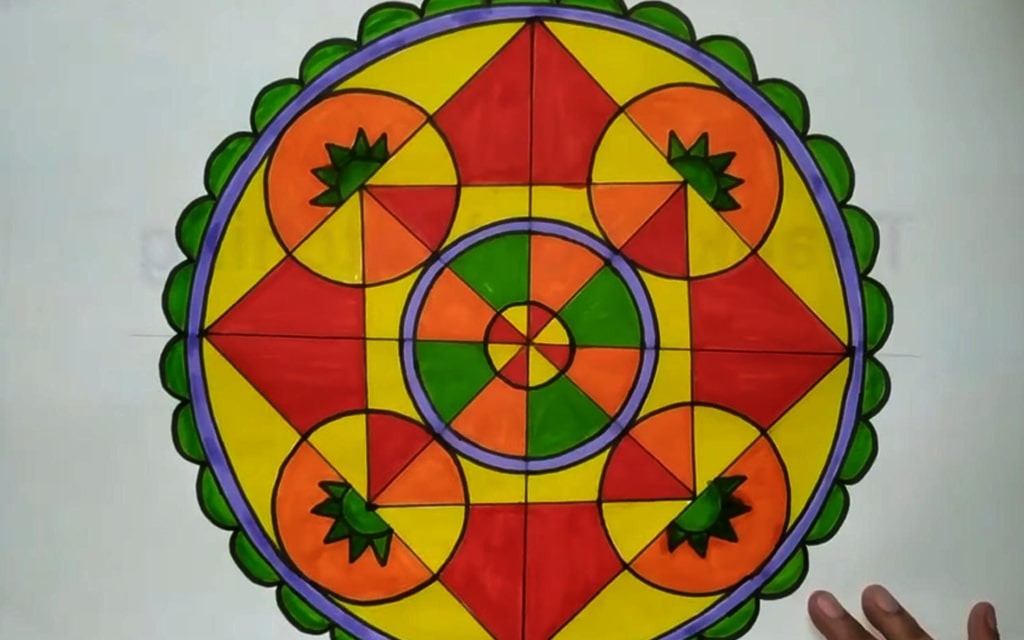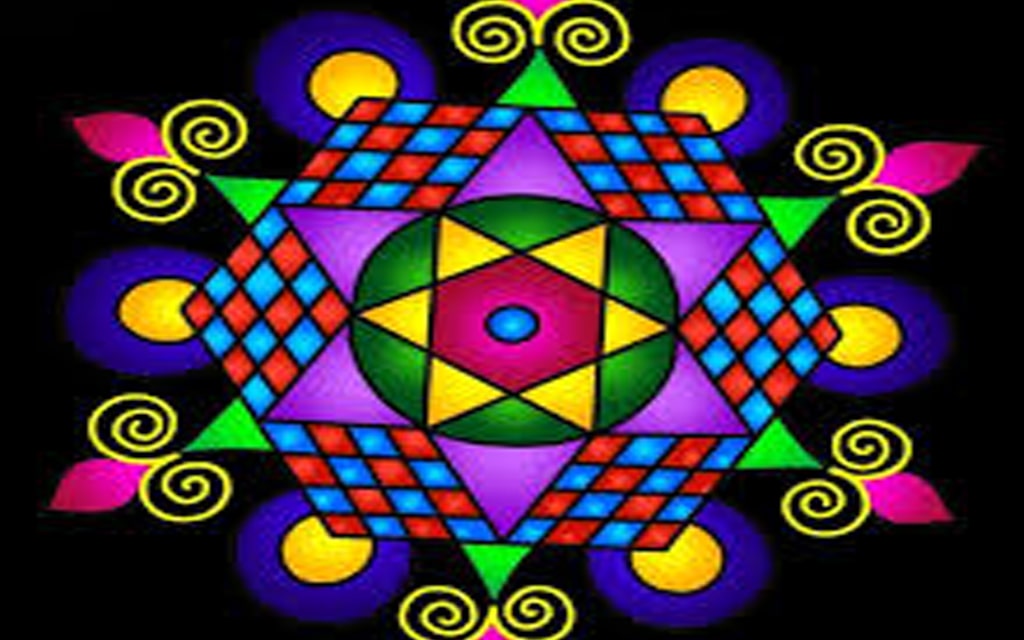Geometric rangoli designs are a captivating and popular choice for creating beautiful patterns on floors during festivals and special occasions in India. These designs are made using geometric shapes such as circles, triangles, and squares, resulting in visually appealing and symmetrical patterns.
They can range from simple and easy designs to more intricate and complex ones. Geometric rangoli designs offer a perfect blend of tradition and modern elegance, making them suitable for every occasion.

Looking for simple geometric rangoli designs that are easy to create? Interested in exploring the art of rangoli design with geometric shapes?
In this article, I will take you on a journey through the mesmerizing world of geometric rangoli designs, providing you with inspiration and ideas for your next rangoli creation.
Table of Contents
- 1 The Significance of Rangoli Designs
- 2 Historical Background of Rangoli Designs
- 3 Materials and Techniques for Creating Geometric Rangoli Designs
- 4 Festivals and Occasions for Geometric Rangoli Designs
- 5 Conclusion
- 6 FAQ
- 6.1 What are geometric rangoli designs?
- 6.2 What is the significance of rangoli designs?
- 6.3 What is the historical background of rangoli designs?
- 6.4 What materials and techniques are used to create geometric rangoli designs?
- 6.5 When are geometric rangoli designs used?
- 6.6 What is the appeal of geometric rangoli designs?
- 7 Source Links
The Significance of Rangoli Designs
Rangoli designs have deep cultural and religious significance in India. The term “rangoli” originates from the Sanskrit words for “colour” and “row,” symbolizing a decorative pattern made with coloured powders, rice, flowers, or other materials.
These designs are believed to bring good luck, prosperity, and positive energy to the household. Rangoli designs are often used to welcome guests into the home and are an integral part of various Indian festivals and celebrations.
The Cultural Significance
- Rangoli designs represent a form of artistic expression, passed down through generations, and showcase the rich cultural heritage of India.
- They create a sense of harmony, balance, and symmetry, as they are made using geometric shapes and patterns.
- Rangoli also symbolizes the unity and interconnectedness of all things, as it is created using natural materials found in the environment.
The Religious Significance
- Rangoli designs are believed to invite the deities and bring their blessings into the home, creating a sacred and auspicious environment.
- They are created as offerings to deities during special religious ceremonies and festivals, such as Diwali, Navratri, and Ganesh Chaturthi.
- The vibrant colours used in rangoli designs represent the divine and are thought to attract positive energies and ward off negative influences.
From welcoming guests to invoking divine blessings, rangoli designs hold great importance in Indian culture.
Their intricate patterns and vibrant colours not only add beauty to homes but also serve as a medium for self-expression and celebration.
Whether made with coloured powders, rice flour, or flowers, rangoli designs continue to be an integral part of Indian traditions, reflecting the country’s rich cultural tapestry.
Historical Background of Rangoli Designs
Rangoli designs have a deep-rooted history in Indian culture, dating back several centuries. These beautiful patterns have evolved over time, starting as a simple way to feed ants and birds and symbolize harmony with nature.
Originally made using rice flour, rangoli designs were a form of offering to nature and a way to invite good fortune into the home.
As time went on, rangoli transformed into a form of artistic expression and storytelling. Different regions in India developed their own unique styles of rangoli, each with its own distinctive patterns, motifs, and cultural influences.
For example, the Alpana style in West Bengal showcases intricate and symmetrical designs, while the Kolam style in Tamil Nadu features geometric patterns drawn using rice flour.
Evolution of Rangoli
Throughout history, rangoli designs have evolved and adapted to changing times and influences. With the introduction of new materials and techniques, the art form has become even more vibrant and diverse.
Today, artists and enthusiasts use a variety of materials, including coloured powders, flower petals, chalk, and even acrylic paints, to create stunning and intricate rangoli designs.
Regional Styles of Rangoli
The regional styles of rangoli vary across India, showcasing the cultural diversity of the country. In addition to Alpana and Kolam, other regional styles include Madana in Rajasthan, Aripan in Uttar Pradesh, Chowkpurana in Punjab, and Saathiya in Gujarat.
Each style has its own unique characteristics and significance, reflecting the rich heritage and traditions of the respective regions.
Materials and Techniques for Creating Geometric Rangoli Designs
Creating stunning geometric rangoli designs is a delightful and artistic endeavor. To bring these mesmerizing patterns to life, you will need a few essential materials and employ specific techniques.
Let’s explore the materials and techniques that can help you create your own beautiful geometric rangoli designs.
Materials for Rangoli:
- Vibrant coloured powders: These powders, known as rangoli colours, are available in a variety of shades and can be used to create intricate designs.
- Rice flour: A traditional material for rangoli, rice flour can be used to make fine lines and outlines in your design.
- Turmeric, vermillion, and natural dyes: These materials can be used to enhance the colours and add depth to your rangoli.
- Flower petals: Introducing the vibrant colours of flower petals can bring a fresh and fragrant touch to your rangoli.
- Coloured sand and chalk: These modern materials offer a convenient alternative to powders and can be easily applied to create intricate patterns.
- Acrylic paints: If you prefer a long-lasting rangoli design, acrylic paints can be used on surfaces like wood or canvas.
Techniques for Creating Rangoli:
Once you have your materials ready, you can begin creating your geometric rangoli design using the following techniques:
- Start by drawing the outline: Use chalk or a pencil to draw the basic shape of your rangoli design on the floor or surface.
- Fill in the design: Use your chosen materials, such as coloured powders or sand, to fill in the design within the outline. You can apply the materials with your fingers or use a small spoon or funnel for precision.
- Experiment with patterns and motifs: Geometric shapes, intricate patterns, flowers, and religious symbols are commonly used motifs in geometric rangoli designs. Feel free to experiment and create your own unique combinations.
- Add finishing touches: Once you’ve completed filling in the design, you can add final embellishments like flower petals, small diyas (oil lamps), or decorative elements to enhance the overall look of your rangoli.
With these materials and techniques at your disposal, you can create stunning geometric rangoli designs that showcase your creativity while embracing the rich cultural heritage of India.

Festivals and Occasions for Geometric Rangoli Designs
Geometric rangoli designs are a vibrant and integral part of various festivals and occasions in India. These mesmerizing patterns not only enhance the beauty of homes and public spaces but also hold deep cultural significance.
Let’s explore some of the festivals and occasions where geometric rangoli designs take center stage.
Diwali – The Festival of Lights
Diwali, also known as the Festival of Lights, is one of the most widely celebrated festivals in India. During Diwali, geometric rangoli designs adorn the thresholds and courtyards of homes to welcome Goddess Lakshmi, the deity of wealth and prosperity.
These colourful patterns are believed to bring good luck and positive energy into the household. The intricate geometric shapes and vibrant colours of rangoli add to the festive atmosphere, creating a sense of joy and celebration.
Pongal – The Harvest Festival
Pongal, the harvest festival celebrated primarily in Tamil Nadu, is another occasion where geometric rangoli designs hold great significance.
Known as Kolam, these rangoli designs are created using rice flour, symbolizing gratitude towards the Sun God for a bountiful harvest. The geometric patterns drawn with rice flour are not only aesthetically pleasing but also represent the unity and harmony of nature.
Kolam rangoli designs are an expression of gratitude and a way to seek blessings for prosperity and abundance.
Geometric rangoli designs also play a prominent role during Navratri, a nine-night festival dedicated to Goddess Durga.
These vibrant patterns adorn the entrances of houses and temples, symbolizing the presence of the divine. Geometric rangoli designs are also a common sight during other cultural celebrations like Onam in Kerala, Makar Sankranti in various parts of India, and regional festivals across the country.
These designs reflect the diversity of Indian traditions and add to the festive spirit.

Geometric rangoli designs have become an integral part of Indian festivals and occasions, celebrating the rich cultural heritage of the country.
From Diwali to Pongal, these vibrant patterns bring joy, prosperity, and a sense of unity. The intricate geometric shapes, intricate motifs, and vibrant colours of geometrical rangoli designs add a touch of elegance and beauty to the festivities, creating a visual spectacle for all to admire and enjoy.
Conclusion
Rangoli designs showcase the mesmerising beauty and artistic expression that is deeply rooted in Indian cultural heritage. These intricate patterns, created with vibrant colours and geometric shapes, add a touch of elegance to homes and public spaces. They are not just decorative art but also a form of self-expression and celebration.
Geometric rangoli designs have stood the test of time, captivating people with their symmetrical patterns and visual appeal.
Whether it’s the traditional motifs passed down through generations or the modern variations that incorporate new materials and techniques, these designs continue to enchant and inspire.
As a proud part of Indian culture, rangoli designs reflect the diversity and richness of our traditions.
They are a way to celebrate festivals, welcome guests, and express gratitude. Through rangoli, we preserve our cultural heritage and showcase our artistic talent to the world.
So, dive into the captivating world of geometric rangoli designs, where tradition meets trend, and experience the mesmerising beauty that has been enchanting generations.
Let these vibrant patterns be a reminder of the artistic expression and rich cultural heritage that defines India.
>> You may also like:
FAQ
What are geometric rangoli designs?
Geometric rangoli designs are captivating and visually appealing patterns made on floors using geometric shapes such as circles, triangles, and squares. They are a popular choice for festivals and special occasions in India.
What is the significance of rangoli designs?
Rangoli designs hold a deep cultural and religious significance in India. They are believed to bring good luck, prosperity, and positive energy to the household. Rangoli designs are also used to welcome guests and are an integral part of various Indian festivals and celebrations.
What is the historical background of rangoli designs?
Rangoli designs have a rich history dating back several centuries. Initially, they were created using rice flour as a way to feed ants and birds and symbolize harmony with nature. Over time, rangoli evolved into a form of artistic expression and storytelling, with different regions in India having their distinct styles.
What materials and techniques are used to create geometric rangoli designs?
Traditional materials for creating rangoli include vibrant coloured powders, rice flour, turmeric, vermillion, and natural dyes. Modern variations incorporate materials like flower petals, coloured sand, chalk, and acrylic paints. The process involves drawing an outline and filling the design with colours or materials of choice.
When are geometric rangoli designs used?
Geometric rangoli designs are an integral part of various Indian festivals and celebrations. They are made during Diwali to welcome Goddess Lakshmi, the deity of wealth and prosperity, and on occasions like Pongal and Navratri. They add to the festive atmosphere and reflect the diversity and richness of Indian traditions.
What is the appeal of geometric rangoli designs?
Geometric rangoli designs exemplify the beauty, creativity, and cultural heritage of India. They not only add aesthetic value to homes and public spaces but also serve as a means of self-expression and celebration. Whether traditional motifs or modern variations, geometric rangoli designs continue to enchant with their mesmerizing beauty.
